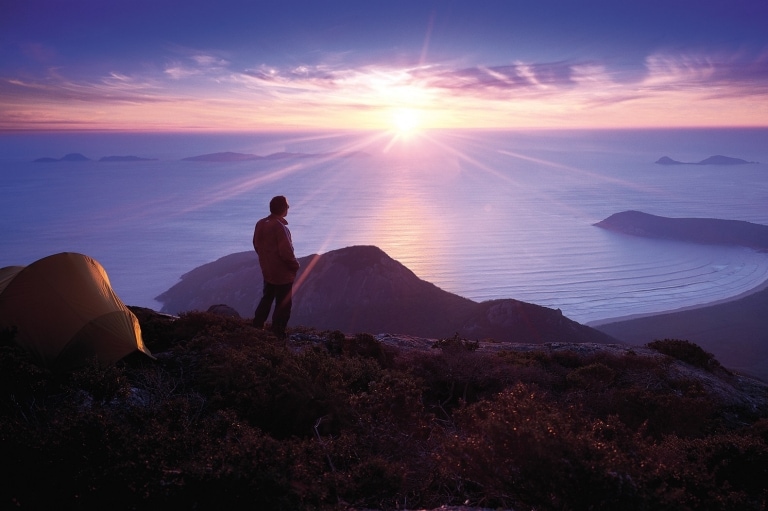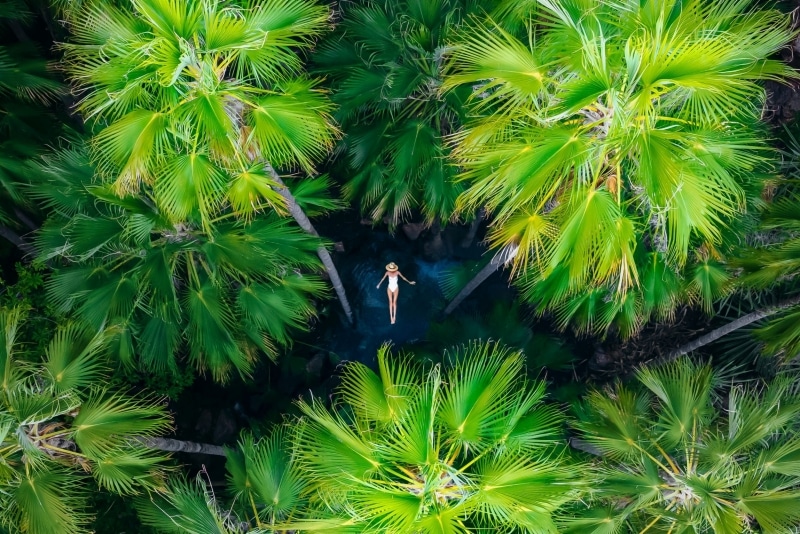
Australia’s best national parks
Ancient, ethereal and unlike anything you’ve ever seen; Australia’s national parks will take your breath away.
Looking up at Uluru-Kata Tjuta – the world’s largest sandstone monolith and a sacred site to the local Anangu people – is truly grounding. Often referred to as the spiritual heart of Australia, Uluru soars above the Red Centre’s burnt orange, 500-million-year-old landscape. Feel connected to the region during an Aboriginal guided walk and don’t miss the mesmerising domes of Kata Tjuta, Uluru’s lesser-known neighbour.
Kakadu, Australia’s largest national park located three hours from Darwin, is as wild as it is wondrous. Waterways snake through monsoon rainforests, towering sandstone escarpments give way to cascading waterfalls and billabongs come alive with birdlife and crocodiles. Seek out Aboriginal rock art more than 20,000 years old, fly above thundering falls and watch the sunset’s pink hues melt over the outback on a billabong cruise.
Some 425km (264mi) north of Adelaide, Ikara-Flinders Ranges National Park’s arresting red earth meets granite mountains and tree-lined gorges to create an extraterriestial-like landscape. Wilpena Pound, a ring of ancient mountains enclosing a sunken amphitheatre, is the main attraction. But you wouldn’t know it from the peacefulness felt here. Settle in at Wilpena Pound Resort, where guided walks, Adnyamathanha culture and wildlife await.
The Daintree Rainforest, just 2.5 hours from Cairns, is more than 180 million years old, making it the oldest continually surviving rainforest in the world. Beneath the canopy, wildlife including crocodiles, tree kangaroos and cassowaries rustle amid more than 3,000 species of plants. For the full Daintree experience, join a Ngadiku Dreamtime Walk to gain a deeper understanding of the First Nations Kuku Yalanji culture.
Stumbling upon trickling waterfalls deep within the Blue Mountain’s temperate rainforest, it’s hard to believe that just a one-hour drive lies between you and Sydney. Aptly named for its blue-hued sandstone ridges that soar over dense bushland, this World Heritage-listed region is a nature-lovers paradise. Seek out hidden waterfalls, wander through moss-coated eucalyptus trees and take a cablecar over valleys at Scenic World.
Just a two-hour drive from Tasmania’s Launceston, Cradle Mountain commands your attention. Here, dramatic snow-capped ridges frame glacial lakes and golden grasslands abound with wombats, echidnas and pademelons. Each season brings its own enchantment to the mountains, from winter’s sparkling snow to autumn’s flaming orange fagus. There are so many wants to explore, too, with horseback riding, canyoning and guided hikes on offer.
Located 150km (93mi) north of Geraldton in Western Australia, Kalbarri National Park is one of nature’s finest works of art. Its dramatic gorges were formed more than 400 million years ago, creating an arresting scene of wind-carved cliffs and in spring, a dizzying display of wild flowers. Wander the Kalbarri Skywalk that hangs 100m (328ft) over the Murchison River, or take the best seat in the house at the iconic Nature’s Window lookout.
Freycinet National Park, a 2.5-hour drive from Hobart, is brimming with awe-inspiring scenery. The majestic Hazards mountain range towers over coastal woodland. The curvaceous Wineglass Bay boasts snow-white sand and impossibly turquoise water. Keen hikers will relish the chance to scramble up Mount Amos, while families can lace up for the 3km (1.8mi) Wineglass Bay Lookout, abundant with grass-munching wallabies. After, put your feet up at the stunning Freycinet Lodge.
Wilsons Promontory, also known as “The Prom”, is Victoria’s oldest national park. The reserve, which sits on the state’s southernmost tip, covers a mighty 50,000 hectares (123,500 acres) with granite peaks, cool gullies and beaches covered in sand that squeaks beneath your feet. Meet wildlife (kangaroos, emus, wombats and echidnas) on the Mount Oberon Nature Walk, or jump on a Pennicott Wilderness Cruise to marvel at the Wilsons Promontory Marine Park.
Located on the western point of Kangaroo Island, a 4.5-hour drive from Adelaide, Flinders Chase National Park has hidden beaches, gushing rivers and heritage lighthouses. But perhaps the park’s biggest drawcard is its rock formations. Visit Admirals Arch, a natural stone arch formed by the powerful Southern Ocean and the home to a colony of frolicking fur-seals. The Remarkable Rocks – a collection of boulders that balance above the sea – live up to their name.
Western Australia’s second largest national park, Karijini is a vibrant landscape orange earth, red gorges and turquoise swimming holes. Whether you hit the fern-lined 2km (1.2mi) Gorge Rim track, seek out waterfalls pouring over jagged rocks or tackle the mighty 9km (5.6mi) Mount Bruce Summit, you’ll not believe the beauty of this outback utopia. Have a safari-style stay at Karijini Eco Retreat.
The Grampians (Geriwerd) is celebrated for its prehistoric mountain peaks that lie just a 2.5-hour drive from Melbourne. Hikers will be rewarded with more than just dazzling views; this ancient landscape holds more than 60 Aboriginal rock art sites, accessed via the Rock Art Trail. The region is a hotbed for wineries and farm-to-fork restaurants, too. Stop by the Royal Mail Hotel, serving award-winning cuisine at the foothills of Mount Sturgeon.




































































































































































































